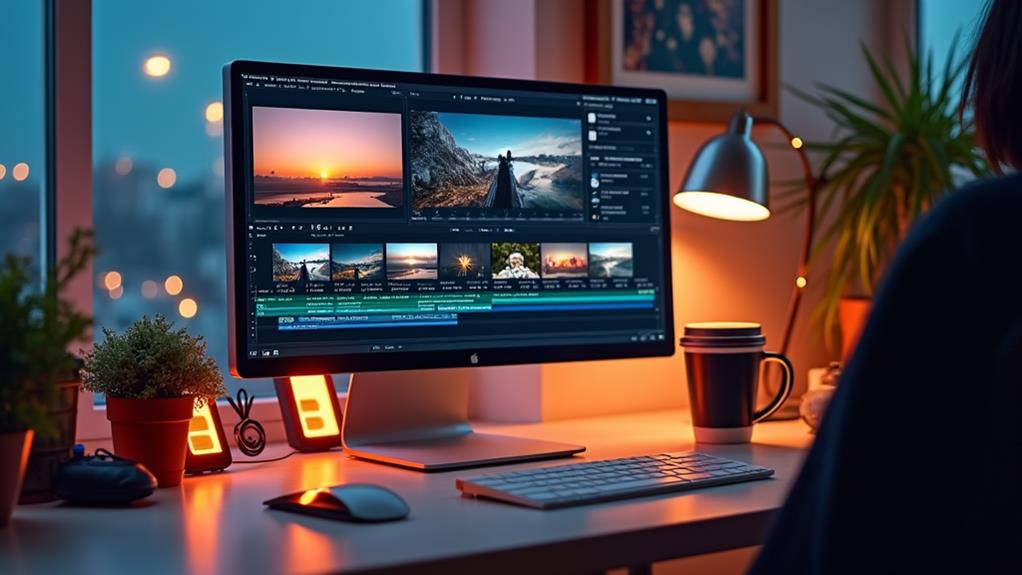Repurpose webinar content into evergreen blog posts by transforming key points into structured recaps, thereby enhancing reader comprehension and engagement. Integrating multimedia elements, such as videos and infographics, enriches the narrative and caters to diverse learning preferences. Improve visibility through strategic SEO optimization, including keyword integration and meta descriptions. Utilize audience insights by building posts around common webinar questions and incorporating poll results to address trending topics. Promoting these posts across various channels, such as social media and email campaigns, boosts exposure and traffic. To discover more on effective strategies, consider exploring further into these techniques.
Key Takeaways
- Summarize webinars into structured recaps highlighting key points for easy reader comprehension and long-term relevance.
- Include multimedia elements like recorded webinars and infographics to cater to diverse learning styles and increase engagement.
- Conduct keyword research to optimize blog content for SEO, enhancing search visibility and organic traffic.
- Create a FAQ section addressing common audience questions to provide valuable insights and evergreen content.
- Promote the blog post across social media and email marketing to amplify reach and maintain audience interest.
Transform Webinars Into Blogs
Transforming webinars into blogs is a strategic approach to maximize content utility and broaden audience reach. This method of content recycling not only extends the lifespan of the original material but also enhances webinar engagement by reaching audiences who prefer written content.
Starting with the webinar outline, one can craft a structured recap blog post that highlights key points discussed during the session. This structured approach guarantees that readers can easily follow along, capturing the essence of the webinar succinctly.
Embedding the recorded webinar video within the blog post further enriches the content by offering a multimedia experience that caters to different learning preferences, thereby enhancing engagement.
Additionally, extracting audience questions and moderator notes to develop an FAQ section addresses common queries, offering added value and increasing the blog's utility.
Incorporating relevant quotes or statistics shared during the webinar bolsters the blog's credibility and encourages sharing on social media, thus amplifying its reach.
Furthermore, optimizing the blog post for SEO by integrating keywords and phrases from the webinar enhances visibility in search engine results, attracting organic traffic and expanding the audience spectrum effectively.
Leverage Visual Elements
Building on the foundation of transforming webinars into blogs, leveraging visual elements is a powerful strategy to further enhance content engagement and retention. Infographic design and visual storytelling are key tools in this endeavor, making complex data from webinars more digestible and engaging for readers. By incorporating high-quality images and graphics, blogs not only become more aesthetically pleasing but also greatly boost engagement—up to 94% more than text alone. This visual appeal encourages readers to linger longer on the page, effectively reducing bounce rates.
To strategically integrate visuals, consider using charts and infographics to simplify intricate data, while screenshots or excerpts from the webinar can provide context and reinforce key points. Visual storytelling through videos or slideshows can encapsulate the essence of the webinar, appealing to a broader audience, particularly those who favor visual learning.
Here is a table to illustrate the emotional impact of visual elements:
| Visual Element | Emotional Impact |
|---|---|
| Infographics | Clarity and Understanding |
| Charts | Simplification of Complexity |
| High-Quality Images | Engagement and Aesthetics |
| Screenshots | Context and Reinforcement |
| Videos/Slideshows | Broadened Accessibility |
Optimize for SEO
Maximizing the reach and impact of repurposed webinar content requires a strategic approach to search engine optimization (SEO). To effectively optimize your blog posts, begin with thorough keyword research to identify terms from the webinar title and content that align with user search intent. This guarantees your content strategy is tailored to meet the needs of your target audience, thereby enhancing search visibility.
Structuring your blog post with header tags (H1, H2, H3) is vital for both search engines and readers. These tags not only help in indexing but also improve readability, guiding users through your content seamlessly.
Additionally, crafting compelling meta descriptions and optimizing alt text for images with relevant keywords and calls to action can appreciably boost click-through rates from search results.
Incorporate internal links to other related posts or resources on your site to maintain reader engagement and improve overall SEO performance. This practice encourages exploration of your content ecosystem, enhancing user experience.
Integrate Audience Insights
Harnessing audience insights from webinars is a strategic approach to creating compelling and relevant blog content. By documenting audience questions and analyzing their feedback, one can transform these insights into engaging blog posts that address specific interests and concerns. Question analysis not only allows for the identification of trending topics but also aids in tailoring content that resonates with the target audience. Additionally, integrating Q&A insights into your blog fosters deeper discussions and community engagement, directly addressing the inquiries that your audience finds most pertinent.
| Insight Source | Insight Type | Blog Content Strategy |
|---|---|---|
| Audience Questions | Specific Concerns | Develop posts around frequently asked questions |
| Poll Results | Trending Topics | Craft content on popular subjects identified through polls |
| Q&A Sessions | In-depth Discussions | Engage readers with detailed explanations and discussions |
| Moderator Notes | Key Takeaways | Summarize main points for thorough understanding |
| Engagement Metrics | Interest Levels | Focus on high-interest topics for maximum engagement |
Analyzing poll results and leveraging audience engagement metrics, such as viewer retention rates, can further refine your content strategy. These insights guide the creation of targeted blog posts, ensuring alignment with subjects that generated the most interest during the webinar. By integrating these audience insights, blog content becomes not only informative but also intrinsically valuable to readers.
Promote Across Channels
Effective multi-channel promotion is vital for amplifying the reach and impact of repurposed webinar content. By leveraging diverse platforms, you can guarantee your evergreen blog posts reach a broader audience.
Social media platforms are invaluable in this strategy. Sharing compelling snippets of your blog posts not only increases visibility but also drives traffic back to the original content. Utilize eye-catching visuals and engaging captions to capture attention and inspire shares.
Email marketing is another powerful tool to engage your audience. Craft campaigns that highlight key insights from your repurposed blog posts, enticing subscribers to visit your website for more in-depth information. This approach keeps your audience informed and fosters a deeper connection with your content.
Enhancing searchability through SEO strategies is essential. Optimize your blog posts with relevant keywords to attract organic traffic from search engines, guaranteeing your content remains discoverable over time.
Additionally, collaborating with industry influencers or partners for cross-promotion can greatly expand your reach and lend credibility to your content.
Lastly, consider content distribution networks like Medium or LinkedIn, where publishing summaries or excerpts can direct new readers back to your site, maximizing exposure and engagement.
Frequently Asked Questions
How Do I Turn a Webinar Into a Blog Post?
To convert a webinar into a blog post, outline key points and incorporate webinar highlights. Summarize the transcript, enhance audience engagement with embedded clips, and apply SEO strategies. Conclude with a call-to-action directing readers to additional resources.
How to Repurpose Existing Content?
Repurposing existing content involves strategic content transformation. Effective strategies include extracting key insights, reformatting for diverse platforms, and leveraging multimedia elements. This enhances audience engagement, broadens reach, and maximizes the value of original material across multiple channels.
How Do I Promote My Evergreen Webinar?
To effectively promote your evergreen webinar, employ webinar promotion strategies such as creating targeted email campaigns and utilizing social media. Enhance audience engagement techniques by sharing insightful clips and collaborating with influencers to broaden your reach.
How to Repurpose Content for Multiple Platforms?
To effectively manage content distribution across multiple platforms, focus on platform adaptation by tailoring content format and messaging. Utilize strategic insights to guarantee each piece is engaging, maximizing reach and impact by aligning with audience preferences.
Conclusion
Repurposing webinar content into evergreen blog posts necessitates a strategic approach that transforms spoken material into engaging written narratives. By leveraging visual elements and optimizing for SEO, the content gains both aesthetic appeal and discoverability. Integrating audience insights guarantees relevance and resonance, while promoting across multiple channels extends reach and impact. This multifaceted strategy not only maximizes the value of original content but also enhances the organization's digital presence and thought leadership in perpetuity.




